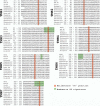Modeling of mammalian olfactory receptors and docking of odorants
- PMID: 28510073
- PMCID: PMC5418400
- DOI: 10.1007/s12551-012-0080-0
Modeling of mammalian olfactory receptors and docking of odorants
Abstract
Olfactory receptors (ORs) belong to the superfamily of G protein-coupled receptors (GPCRs), the second largest class of genes after those related to immunity, and account for about 3 % of mammalian genomes. ORs are present in all multicellular organisms and represent more than half the GPCRs in mammalian species (e.g., the mouse OR repertoire contains >1,000 functional genes). ORs are mainly expressed in the olfactory epithelium where they detect odorant molecules, but they are also expressed in a number of other cells, such as sperm cells, although their functions in these cells remain mostly unknown. It has recently been reported that ORs are present in tumoral tissues where they are expressed at different levels than in healthy tissues. A specific OR is over-expressed in prostate cancer cells, and activation of this OR has been shown to inhibit the proliferation of these cells. Odorant stimulation of some of these receptors results in inhibition of cell proliferation. Even though their biological role has not yet been elucidated, these receptors might constitute new targets for diagnosis and therapeutics. It is important to understand the activation mechanism of these receptors at the molecular level, in particular to be able to predict which ligands are likely to activate a particular receptor ('deorphanization') or to design antagonists for a given receptor. In this review, we describe the in silico methodologies used to model the three-dimensional (3D) structure of ORs (in the more general framework of GPCR modeling) and to dock ligands into these 3D structures.
Keywords: 3D structure modeling; G protein-coupled receptors; Homology modeling; Ligand docking; Virtual screening.
Figures

Similar articles
-
Scents and sense: in silico perspectives on olfactory receptors.J Comput Chem. 2014 Dec 15;35(32):2279-87. doi: 10.1002/jcc.23757. Epub 2014 Oct 18. J Comput Chem. 2014. PMID: 25327850 Review.
-
Mammalian olfactory receptors: molecular mechanisms of odorant detection, 3D-modeling, and structure-activity relationships.Prog Mol Biol Transl Sci. 2015;130:1-36. doi: 10.1016/bs.pmbts.2014.11.001. Epub 2014 Dec 18. Prog Mol Biol Transl Sci. 2015. PMID: 25623335 Review.
-
Automatic modeling of mammalian olfactory receptors and docking of odorants.Protein Eng Des Sel. 2012 Aug;25(8):377-86. doi: 10.1093/protein/gzs037. Epub 2012 Jun 12. Protein Eng Des Sel. 2012. PMID: 22691703
-
Deorphanization and characterization of human olfactory receptors in heterologous cells.Chem Biodivers. 2014 Nov;11(11):1764-81. doi: 10.1002/cbdv.201400083. Chem Biodivers. 2014. PMID: 25408322
-
Identification of agonists for a group of human odorant receptors.Front Pharmacol. 2015 Mar 3;6:35. doi: 10.3389/fphar.2015.00035. eCollection 2015. Front Pharmacol. 2015. PMID: 25784876 Free PMC article.
Cited by
-
Lineage-Specific Class-A GPCR Dynamics Reflect Diverse Chemosensory Adaptations in Lophotrochozoa.Mol Biol Evol. 2025 Mar 5;42(3):msaf042. doi: 10.1093/molbev/msaf042. Mol Biol Evol. 2025. PMID: 39943858 Free PMC article.
-
Binding site identification of G protein-coupled receptors through a 3D Zernike polynomials-based method: application to C. elegans olfactory receptors.J Comput Aided Mol Des. 2022 Jan;36(1):11-24. doi: 10.1007/s10822-021-00434-1. Epub 2022 Jan 1. J Comput Aided Mol Des. 2022. PMID: 34977999 Free PMC article.
-
G protein-coupled odorant receptors: From sequence to structure.Protein Sci. 2015 Sep;24(9):1543-8. doi: 10.1002/pro.2717. Epub 2015 Jun 22. Protein Sci. 2015. PMID: 26044705 Free PMC article.
-
Agonist Binding to Chemosensory Receptors: A Systematic Bioinformatics Analysis.Front Mol Biosci. 2017 Sep 6;4:63. doi: 10.3389/fmolb.2017.00063. eCollection 2017. Front Mol Biosci. 2017. PMID: 28932739 Free PMC article.
-
A two-stage computational approach to predict novel ligands for a chemosensory receptor.Curr Res Struct Biol. 2020 Oct 9;2:213-221. doi: 10.1016/j.crstbi.2020.10.001. eCollection 2020. Curr Res Struct Biol. 2020. PMID: 34235481 Free PMC article.
References
-
- Ballesteros JA, Weinstein H. Integrated methods and computational probing of structure-function relations in g protein-coupled receptors. Methods Neurosci. 1995;25:366–428. doi: 10.1016/S1043-9471(05)80049-7. - DOI
Publication types
LinkOut - more resources
Full Text Sources

